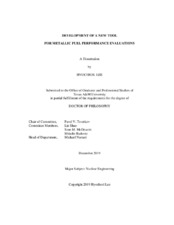| dc.description.abstract | Accurate evaluations of fuel behavior is a crucial part in the determination of fuel operation limits and in the verification of burnup capabilities and reliability characteristics. In-pile behaviors of metallic fuels are closely connected with one another under a wide variety of irradiation histories. In most cases, each individual behavior cannot be evaluated by considering its own physical phenomena in isolation. Due to the high degree of interconnection among the fuel behaviors, the models that predict and quantify the fuel behaviors contain nonlinear mathematical expressions, and the coefficients and boundary conditions of each model are dependent on the calculations of other models. These complex relations generally require an integrated platform which has high-performance computing capabilities to handle the fuel behavior models simultaneously. In this research, a comprehensive computational tool has been developed to provide an optimized platform where each model can communicate with other models to calculate the synergistic effects of the fuel behaviors.
The tool was named Tool for Analyzing Metallic U-Zr Fuel Performance (TAMU-ZFP). The framework of the TAMU-ZFP code was erected by implementing improved thermo-mechanical models in the code with new advanced algorithms. The governing equations (GEs) of the thermo-mechanical models were established for each individual cell of the spatial and temporal mesh employed in the code, and the GEs of a cell were solved with the boundary conditions pertaining to the specific cell. These cell-based models effectively describe the spatial variation and time dependence of thermo-mechanical behaviors. By supplying the specific behavioral history of each cell, the new thermo-mechanical models enable the framework to be an optimized environment for the coupling of fuel performance models. TAMU-ZFP adopted new advanced algorithms to implicitly calculate the synergic effects of the irradiation behaviors. The radial and axial interlocking in a fuel performance calculation, coupling of fuel perform models, contact analysis, and dynamic dimensioning and power adjustment after fuel pin deformation are executed in three main algorithms: open-gap algorithm, serial-contact algorithm, and random-contact algorithm. Also, transient modules that allow one job-step for the simulations of design-based off-normal fuel behaviors were installed in the TAMU-ZFP code. | en |


